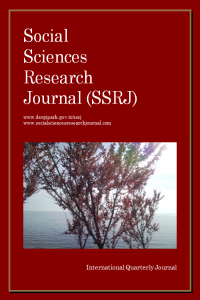Düşük Fiyat Anomalisinin Hisse Senetlerinin Risk-Getiri Performanslarına Etkisi: Borsa İstanbul Örneği
Borsa İstanbul, Düşük Fiyat Etkisi, GARCH, EGARCH, APARCH, GJRGARCH
Impact of Low Price Effect on Risk-Return Performances of Stocks: Evidence from Istanbul Stock Exchange
Istanbul Stock Exchange, Low price effect, GARCH, EGARCH, GJR-GARCH, APARCH,
___
- Bachrach, Benjamin, and Dan Galai. (1979). “The Risk-Return Relationship and Stock Prices.” The Journal of Financial and Quantitative Analysis 14 (2): 421–41. http://www.jstor.org/stable/2330512.
- Bar-Yosef, Sasson, and Lawrence D. Brown. (1979). “Share Price Levels and Beta.” Financial Management 8 (1): 60–63. http://www.jstor.org/stable/3665411.
- Blume, Marshall E., and Frank Husic. (1973). “PRICE, Beta, and Exchange Listing.” The Journal of Finance 28 (2): 283–99. https://doi.org/10.1111/j.1540-6261.1973.tb01772.x.
- Clendenin, John C. (1951). “Quality Versus Price as Factors Influencing Common Stock Price Fluctuations.” The Journal of Finance 6 (4): 398–405. http://www.jstor.org/stable/2976143.
- Dubofsky, David A., and Dan W. French. (1988). “SHARE Price Level and Risk: Implications for Financial Management.” Managerial Finance 14 (1): 6–15. https://doi.org/10.1108/eb013591.
- Edmister, Robert O., and James B. Greene. (1980). “Performance of Super-Low-Price Stocks.” The Journal of Portfolio Management 7 (1): 36–41. https://doi.org/10.3905/jpm.1980.408776.
- Fritzemeier, Louis H. (1936). “Relative Price Fluctuations of Industrial Stocks in Different Price Groups.” The Journal of Business of the University of Chicago 9 (2): 133–54. http://www.jstor.org/stable/2349219.
- Gilbertson, R. A. C., J. F. Affleck-Graves, and A. H. Money. (1982). “Trading in Low Priced Shares: An Empirical Investigation 1968–1979.” Investment Analysts Journal 11 (19): 21–29. https://doi.org/10.1080/10293523.1982.11082195.
- Goodman, David A, and John W Peavy. (1986). “The Low Price Effect: Relationship with Other Stock Market Anomalies.” Review of Business and Economic Research 22 (1): 18–37.
- Heins, A. James, and Stephen L. Allison. (1966). “Some Factors Affecting Stock Price Variability.” The Journal of Business 39 (1): 19–23. http://www.jstor.org/stable/2352012.
- Karan, M. B. and Ekşi C. (2002). İstanbul Menkul Kıymetler Borsası’nda Düşük Fiyat Etkisi. İktisat ve Finans Dergisi. (20E), 48-55.
- Muthoni, Huku L. (2014). “Testing the Existence of Low Price Effect on Stock Returns at the Nairobi Securities Exchange.” University of Nairobi.
- Mutindi, Kiano G. (2015). “The Low Share Price Effect on the Nairobi Securities Exchange.” University of Nairobi.
- Pinches, George E., and Gary M. Simon. (1972). “An Analysis of Portfolio Accumulation Strategies Employing Low-Priced Common Stocks.” The Journal of Financial and Quantitative Analysis 7 (3): 1773–96. http://www.jstor.org/stable/2329802.
- Sevim, Ş. and Akkoç, S. (2007). Sermaye Piyasalarında Düşük Fiyat Etkisi ve İstanbul Menkul Kıymetler Borsası’nda Bir Uygulama. Eskişehir Osmangazi Üniversitesi Sosyal Bilimler Dergisi, 8 (1).
- Siouris, George-Jason, and Alex Karagrigoriou. (2017). “A Low Price Correction for Improved Volatility Estimation and Forecasting.” Risks 5 (3): 1–14. https://EconPapers.repec.org/RePEc:gam:jrisks:v:5:y:2017:i:3:p:45-:d:110079.
- Waelkens, K, and M Ward. (1997). “The Low Price Effect on the Johannesburg Stock Exchange.” Investment Analysts Journal 26 (45): 35–48. https://doi.org/10.1080/10293523.1997.11082375.
- Zaremba, Adam, and Radoslaw Zmudzinski. (2014). “Low Price Effect on the Polish Market.” Financial Internet Quarterly E-Finanse 10 (1): 69–85. http://dx.doi.org/10.2139/ssrn.2374694.
- Yayın Aralığı: Yılda 4 Sayı
- Yayıncı: Denta Florya ADSM Limited Company
Bilgi Gediği Hipotezinde Tekno İyimserlik ve Tekno Kötümserlik
ÖZEL GEREKSİNİMLİ ÇOCUKLARA SAHİP OLAN AİLELERİN EVLİLİK YAŞAMINA TOPLUMSAL CİNSİYET ODAKLI YAKLAŞIM
NEOLİBERALİZM, KÜRESEL ENERJİ SEKTÖRÜ VE SEÇİLMİŞ ÜLKELER BAZINDA ELEKTRİK SEKTÖRÜ ÖZELLEŞTİRMELERİ
Hüseyin Safa ÜNAL, Jülide YALÇINKAYA KOYUNCU
Ayşegül İŞCANOĞLU ÇEKİÇ, Demet SEZER
Türkiye’deki Özel Sermayeli ve Yerli Mevduat Bankalarının CAMELS Analizi
Ötenazi Kavramının Teleolojik, Deontolojik ve Meta-Etik Teoriler Bağlamında Karşılaştırmalı Analizi
Türkiye’de Enflasyon Cari Açık ve Bankacılık Sektörü Kredileri: 2006-2018 Dönemi İçin Bir İnceleme
